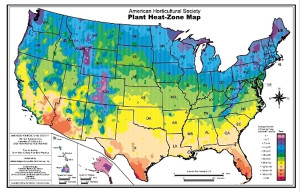The AHS Heat Zone Map isn’t new. The American Horticultural Society developed it in 1960 and updated it in 1990. It has become an important reference for knowing both the cold and heat tolerances of garden plants. Many perennials in southern U.S. gardens struggle in the extreme heat and humidity.
The heat zone map developed by AHS is based on heat, rather than cold, to determine a plant’s ability to survive in a specific location. It uses summer temperatures to demonstrate a specific plant’s ability to survive or handle the stress of high summer temperatures.
The U.S. Heat Zone Map is divided 12 zones. Each is derived from the number of “heat days” or the number of days the temperatures at 86ºF or higher. Each zone is identified by the average number of heat days it experiences in a year.
Heat zones are expressed with the highest heat zones listed first, followed by the lowest. For example, the heat zone rating for balloon flower (Platycodon) is AHS Heat Zone 8-1. This illustrates that Platycodon can tolerate and survive the summer heat in zones 1 through 8 (or 8 through 1). Sweetgum (Liquidambar styraciflua) is rated USDA hardiness 6 to 9, and AHS heat 9 to 6. A plant is listed as having AHS Heat Zone: 9-5, the growing season may be too short or summer temperatures not high enough for plants to flower in zones 1 to 4.
Several environmental factors, such as water, light, daylength, oxygen, and air circulation and pollutants, can skew the accuracy of a particular heat zone. Amount of rainfall is the most critical; plants lacking water are more susceptible to injury from heat.
Some plants vary in the ability to withstand heat, not only from species to species but even among individual plants of the same species! Unusual seasons- fewer or more hot days than normal- will invariably affect results in your garden. Sometimes, individual plant cultivars may survive outside their designated heat zone.
The AHS Heat Zone Map is intended to supplement the USDA Hardiness Zone Map, permitting gardeners to select plants based on their ability to survive seasonal temperature extremes in their region. Unfortunately, many plant labels (tags) still do not list their heat tolerance.



 Posted in
Posted in 
